 |
|

|
 |
TABLE of CONTENTS
|
District 4 employees get the wheels in motion for White Earth Nation’s Boys and Girls Club |
By Jerimiah Moerke, District 4 public affairs coordinator

Children from the White Earth Nation enjoy the new, safer bike trail that runs along Hwy 59 in Mahnomen. Due to the Free Bikes 4 Kidz program, 120 White Earth Nation’s Boys and Girls Club members will soon be able to join them on this trail. Photo by Jane Butzer |
A little luck, a sharp eye by a MnDOT employee and some fast writing led to an exciting success in District 4.
In late September, two District 4 employees attended a grand opening for a new multi-use trail along Hwy 59 in Mahnomen. The event included a bike rodeo, helmet sale and a bike parade.
Jane Butzer, District 4 engineer and bicycle/pedestrian coordinator, attended and noticed some children weren’t a part of the parade.
“I was so sad to see all the kids standing in the road, watching us ride by and waving. They should have been part of it,” Butzer said.
She asked around and learned they were from the local Boys and Girls Club.
By coincidence, just a couple of weeks later Butzer learned about a program in the Twin Cities called “Free Bikes 4 Kidz.” The program accepts new bikes or used bikes to fix up and be given to children without bikes. She immediately thought of the Boys and Girls Club in Mahnomen. But there was a catch. The group only accepted applications from within a 50-mile radius of the Franklin Avenue bridge over the Mississippi River in Minneapolis.
Fortunately, an exception in the application noted, “In some cases (especially organizations that work with tribes/reservations), exceptions can be made.” It turns out the Boys and Girls Club in Mahnomen is managed by the White Earth Nation.
Mary Safgren, District 4 planner, quickly contacted the local Statewide Health Improvement Partnership and the Headwaters Regional Development Commission. The two organizations then contacted the Boys and Girls Club, and together the three groups did the heavy lifting. The Club, SHIP and HRDC completed and submitted the application in just days.
In late October great news came. Even though the Boys and Girls Club requested 75 bikes, they were award 120.
“These bikes will support the health and well-being of our youth across the reservation and we cannot wait to give the kids the opportunity to get out there and enjoy,” said Terri Darco, Boys and Girls Club CEO.
The Boys and Girls Club will work with the organization to get the bikes delivered in December, and MnDOT District 4 has offered assistance, if needed.
“It will be so fun to see the large number of bikes/youth riding throughout the reservation,” Darco said. |
 |
|

|
 |
TABLE of CONTENTS
 |
Salt sustainability goal will lower salt usage |
By Sue Roe
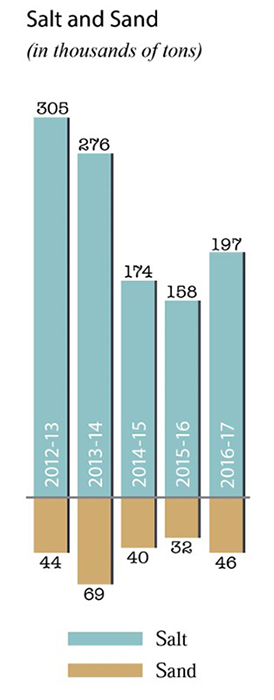
Warmer average temperatures and MnDOT’s use of technologies that improve efficiencies drove down salt usage the past five years. The agency’s new salt sustainability goal will further reduce usage. |
MnDOT’s salt usage has decreased over the past five years, and this winter, the maintenance office is working toward a new salt sustainability goal to help the agency lower the amount it uses on the roadways even more.
“Technology is in place to help achieve our salt sustainability goal,” said Joe Huneke, Road Weather Technology unit supervisor. “The past four or five years we’ve been building up our technology so that we can now say our technology is helping us improve our efficiencies.”
The department set a goal to make graduated progress toward meeting the salt use recommendation of the Maintenance Decision Support System, which provides data on how much salt and other materials to use.
“We already use MDSS to improve our snow and ice operations,” Huneke said. “But we would like to close the gap from where we currently are in our salt usage to where we should be.”
He explained that while MDSS helps MnDOT lower its salt usage, a review of the data shows that salt use still exceeds the level recommended by MDSS.
MnDOT used approximately 18 percent more salt than what MDSS recommended last year. Huneke said there are variances in MDSS, forecast and prediction accuracy and system route configurations that account for the higher salt usage. Work is being done to insure proper data dissemination to provide better accuracy.
“Our five-year goal is to have our actual salt usage be within 10 percent of the recommended MDSS usage,” he said. “This is our initial goal, but we are always exploring ways to work toward less salt, while finding that balance between public safety and environmental concerns.”
To get from 18 percent usage to 10 percent, Huneke said the agency will continue to focus on the 4 Rs of using the right material at the right amount at the right time in the right place.
MnDOT identified these ways to lower salt usage:
- More hands-on training of MDSS and the Automated Vehicle Location system, which feeds data into MDSS. This training helps snowplow operators and other staff efficiently and effectively track and manage resources.
- Use technology to identify hazard and snow trap areas and locations where the agency is now using extra salt, and provide maps to where the agency can use something different than salt. The agency will work to install AVL technology, which passes data to MDSS, in every truck. Currently, all trucks that are newer than 2004 have AVL. That’s 650 out of 850 trucks.
- Create a roles-and-responsibility document that will build accountability into maintenance actions. This includes making sure sanders are calibrated, cross-referencing material usage with the Business Intelligence office to confirm material is getting reported accurately and using post-storm meetings to discuss better ways of managing resources.
- Update the best practices document to guide maintenance decisions. Best practices include anti-icing, pre-wetting and slurry, which help reduce salt usage. These practices are common in some areas, although it may not be considered a best practice in areas of the state that have different factors such as topography, traffic and weather.
- Work with other areas, such as the Office of Environmental Stewardship, to reduce chlorides in the state. The two offices already work together on living snow fences, salt storage and handling and salt runoff issues.
- Explore salt alternatives. This is ongoing as new processes and procedures are always being tested in the state, region and country.
MnDOT’s salt usage decreased from 304,600 tons in 2012-13 to 197,400 tons in 2016-17. This reduction was mainly due to the warmer average temperatures in the past few years and the agency’s efforts to use salt only when necessary.
“There are environmental reasons for our salt decrease, but we also want to rely on the science of the MDSS technology that will help us continue to use less salt,” Huneke said.
The salt reduction goal is part of MnDOT’s overall environmental and economical sustainability efforts to work toward the most efficient and effective methods of snow and ice control to prevent road salt from entering lakes and rivers. See report. Visit the sustainability webpage. |
 |
|

|
 |
TABLE of CONTENTS
 |
Office of Civil Rights brings together mentors, protégés to create successful partnerships |
|
By Mary McFarland Brooks
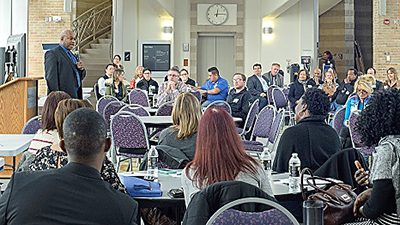
Ashanti Payne, Office of Civil Rights, addresses attendees at Mentor Protégé event at Metro State University. Photo by David Gonzalez |
The Office of Civil Rights hosted the Second Annual Mentor Protégé Networking event in early November at Metro State University, attracting more than 34 Disadvantaged Business Enterprises represented and 10 prime contractors, along with partnering agencies and MnDOT staff.
The Office of Civil Rights’ Ashanti Payne, business and program development manager, and George Costilla, business development advisor, kicked off the program by explaining the advantages of partnering in the construction world.
Lynn Pingol, MnDOT’s small business resource center director, led an interactive exercise that included contractors and DBEs and addressed techniques for successful project bidding.
Subsequent breakout sessions addressed identifying opportunities for small businesses to participate on, and become, pre-qualified for projects.
Small businesses that obtained certification in business and financial management through OCR’s business skills courses were recognized in an award ceremony. Small businesses that completed an in-depth business assessment and business development plan offered by IMO Consulting Group were also recognized.
Participants also had the opportunity to network and visit booths staffed by prime contractors and partnering agencies.
“The proven success of the mentor-protégé program encourages firms to share their expertise and resources,” said Kim Collins, Office of Civil Rights director. “We have seen that networking and cultivating relationships between large and small firms helps them both learn how to better compete on projects and in new markets.”
The Mentor Protégé Program is provided by the Small Business Development Unit in partnership with the Minnesota Unified Certification Program, whose purpose is to further the development of certified DBE firms to encourage them to:
- Move into non-traditional areas of work
- Compete in the marketplace outside the DBE program
- Develop their capacity to compete on projects
As a mentor, the most common types of assistance that would be offered a protégé include:
- Business planning
- Bidding and estimating
- Record keeping
- Technical assistance
- Capital formation
- Financial counseling
- Bonding
- Equipment use
The type of mentor protégé agreements will vary based on the needs of the businesses involved, the type of projects available and the experience of the protégé. Successful outcomes generally result when both parties are fully vested in the steps necessary for the growth and development of the protégé.
OCR looks for opportunities in the upcoming construction season to encourage mentor protégé agreements for interested DBEs and contractors. To learn more, contact George Costilla at george.costilla@state.mn.us or 651-366-3332. |
 |
|

|
|

|
 |
TABLE of CONTENTS
 |
Employees encouraged to reduce email storage during clean-up efforts |
|
By Rich Kemp
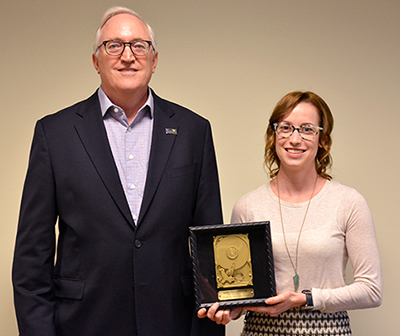
Bill Gardner, Office of Freight and Commercial Vehicle Operations director, and Anna Craig, OFCVO office administrative specialist, received the Golden Hard Drive during the spring shared drive reduction initiative. Photo by Rich Kemp |
During the month of December, MnDOT offices and districts will be encouraged to eliminate excess email as part of an agencywide clean-up effort. The clean-up supports the strategy of promoting data governance across the agency by disposing of information that is no longer needed and storing information in the correct place.
Last year the effort was for one week. Agencywide, there was a 6.78 percent reduction during the clean-up effort. This time it will be for the whole month of December.
“It is good business practice to get rid of things we don’t need and follow the retention schedule,” said Jennifer W. Witt, management analyst supervisor in the Office of Chief Counsel. “It’s basically records maintenance, caring for our information assets as we care for our infrastructure assets.”
The office or district that reduces its email storage by the highest percentage will win the MnDOT Golden Hard Drive. The first data storage clean-up week was held in spring 2016.
Previous Golden Hard Drive winners were:
- Office of Communications – Spring 2016
- Office of Civil Rights – Fall 2016
- Office of Freight and Commercial Vehicles Spring 2017
Employees will again be asked to dedicate four hours during December to review their emails and delete outdated non-record (redundant, obsolete or trivial) emails or delete records that have reached the end of their retention period.
If there are any records found in the email, fill out a records destruction report for all records that are deleted. State law requires all agencies to permanently retain a list of destroyed records.
Storage levels will be posted weekly on the Records Management webpage. The reduction will be measured by percentage so that larger districts or offices do not have an unfair advantage. The district or office with highest percentage of decrease to their email storage footprint will receive the Golden Hard Drive trophy. The winner will be announced Jan. 5. |
 |
|

|
 |
TABLE of CONTENTS
 |
MnDOT offices, districts participate in statewide military appreciation campaign |
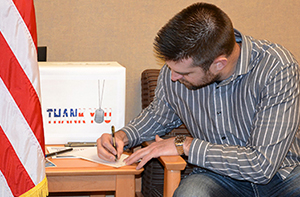 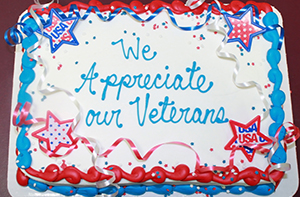
Gov. Mark Dayton proclaimed November as Veteran and Service Member Appreciation Month. To honor veterans, MnDOT employees wrote thank you letters to veterans, and employees who are veterans were presented with a commemorative military coin. In the photo above left, Brett Paasch, engineer, District 7 Mankato traffic office, writes a letter to a veteran. Photo by Rich Kemp. Above right, Cassandra Isackson, Aeronautics director, and Kathy Vesely, assistant director, surprised everyone at an Office of Aeronautics meeting Nov. 21, with a veteran’s appreciation cake. All the veterans were acknowledged and thanked for their service. Photo by Dan McDowell. Below, Commissioner Charlie Zelle presents a coin to Joseph Musolf, Eden Prairie Truck Station (left), and Kevin Millage, Metro signal operations. Photo by David Gonzalez.
Employees are encouraged to write a note by Nov. 30, thanking a veteran for their service.

|
|
 |
|

|
 |
TABLE of CONTENTS
 |
Leadership Development Program helps employees with talent management, individual development plans |
By Carol Hennekens, Workforce Development
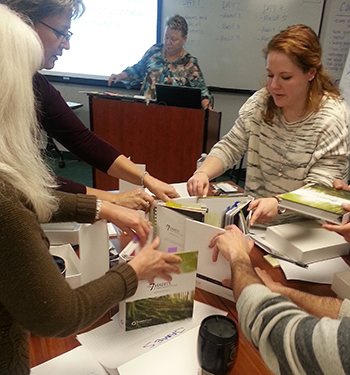
Employees work on an exercise in the “The 7 Habits of Highly Effective People” course as part of the Leadership Development Program. Photo by Amanda Klawiter |
Have you been involved in the talent management process or have you completed an Individual Development Plan?
Talent management identifies a team’s current knowledge and skill sets and identifies goals for future development. IDPs are created by individual employees to set goals for development. Once these plans are in place, it is time to start accomplishing those goals and move forward to get results.
So, how can we do that cost effectively and get our work done at the same time?
One solution is to get involved with the Leadership Development Program, which has been around since 2012. More than 1,200 employees have participated, with many employees participating year after year to keep their skills sharp. This unique program allows participants to customize learning and provides a structure to allow employees to work towards their individual development goals while still accomplishing work goals.
The next LDP group starts March 1, 2018. The enrollment period begins Dec. 11, 2017 and ends Jan. 19, 2018. The process to enroll is simple - complete the Commitment Agreement with all signatures and send it to the LDP Team by Jan. 19, 2018.
For further information about the program, check out the LDP website found on iHUB. Or attend an information session through Skype. Information session dates and times can be found on the LDP website. To register for a session, send an email to the LDP Team with the date you want to attend. |
 |
|

|
 |
TABLE of CONTENTS
 |
Employees engage in fraud awareness, prevention |
By Jesse Johnson, Finance Special Services

Scott Murphy, District 6, was one of the winners of the Fraud Awareness and Prevention quiz and received a prize for getting all 10 questions correct. Photo courtesy of District 6 |
Safeguarding MnDOT coordinated Fraud Awareness and Prevention Week Nov. 13-17. Posters displayed at all MnDOT locations and webinars communicated actions employees can take to prevent fraud.
Commissioner Charlie Zelle kicked off the week with an email highlighting the responsibility all employees share in preventing fraud, waste and abuse at MnDOT, setting the agency’s “tone at the top.” Daily Fraud Fact emails were then sent out each day, by one of the assistant commissioners.
Two Fraud Awareness and Prevention webinars were held, with an emphasis on where fraud has happened within the state of Minnesota, how fraud can happen in state government and ways in which employees help prevent fraud at MnDOT. A total of 146 employees participated in the webinars.
A highlight of the week was the Fraud Awareness and Prevention Knowledge Quiz. This multiple choice quiz had 10 questions based on information from the Daily Fraud Fact emails, as well as the Fraud Awareness and Prevention Webinar. Of the 45 employees who submitted a completed quiz, 21 participants were eligible to win a prize, having earned a perfect 10 of 10 correct answers. Answers to the quiz can be found on the Safeguarding MnDOT iHUB site.
Scott Murphy, District 6; Betty Winter, Bridge Office; and Roger Thompson, District 3, each won a prize.
“We would like to thank everyone for participating in the Fraud Awareness and Prevention Week events, and would like to thank all employees for their continuous efforts to prevent fraud, waste and abuse at MnDOT,” said Candy Harding, Safeguarding MnDOT coordinator. |
 |
|

|
 |
TABLE of CONTENTS
 |
MNIT offers accessible Word document training |
|
Ensuring that the documents MnDOT creates are accessible, just got easier, thanks to new training available from the MNIT Office of Accessibility. The seven online modules for accessible Word documents include:
- Introduction to accessible documents
- Working with styles
- Working with colors
- Formatting with columns, hyperlinks and objects
- Working with tables
- Document basics and accessibility checker
- Converting Word documents to PDF
While the training focuses on Microsoft Word, you can apply its principles to any digital document creation tool. At the end of each module, once you understand the principles, you can get a certificate of completion for that module.
Check out the training on the MNIT website. Any issues with the training modules can be sent to mnitaccessibility@state.mn.us.
Find other accessibility resources on iHUB here: http://ihub/communications/adaweb.html. |
 |
|

|
 |
TABLE of CONTENTS
 |
Minnesota receives National Roadway Safety Award |
By Sue Roe

Chevrons were added to this rural curve as a safety strategy. Chevron warning signs reduce road departure crashes in curves by 16 percent. In rural Minnesota, 50 percent of severe road departure crashes occur on curves. Photo by David Gonzalez |
MnDOT and its county partners received national honors Nov. 15 for the success of its “Implementation of Data Driven Safety Solutions” program to reduce fatal crashes on county roads.
Minnesota was one of nine states to receive the prestigious 2017 National Roadway Safety Award, a biannual awards program sponsored jointly by the Roadway Safety Foundation and the Federal Highway Administration. The awards, which were presented in Washington, D.C., recognize roadway safety achievements that move the U.S. toward zero deaths and serious injuries on the nation’s roadways.
State crash data indicate that county roads account for half of all fatal crashes, even though they account for less than a quarter of vehicle miles traveled in the state. To address this, MnDOT and the Minnesota County Engineers Association worked with counties to develop county road safety plans for all 87 Minnesota counties, emphasizing low-cost, systemic improvements over high-cost reactive treatments.
“The implementation of the county roadway safety plans by our local partners have made an actionable difference in saving lives on Minnesota’s roadways, helping to drive us towards our goal of zero roadway-related deaths,” said Mark Vizecky, State Aid Programs engineer.
The plans contain 330 low-cost, proactive safety improvements on county roads that resulted in a 25 percent reduction in the county road fatality rate over the subsequent four years.
Improvements included signs on curves, pavement marking enhancements, rumble strips and stripes, intersection lighting and intersection signing and pavement marking installations.
Projects were evaluated on effectiveness, innovation and efficient use of resources. The program honors projects in two categories: infrastructure and operational improvements, and program planning, development and evaluation.
“The National Roadway Safety Awards are an opportunity to recognize the unsung heroes who plan, engineer and implement creative measures to help save lives on a daily basis and rarely receive credit for doing so,” said Gregory Cohen, RSF executive director.
MnDOT received two roadway safety awards in 2011 for the development of local roadway safety plans in Wright County and for using microsurfacing to prevent wet weather crashes.
More information on the national awards program can be found on their website. |
 |
|

|
 |
TABLE of CONTENTS
 |
Maple Grove truck station’s safety record is at 1,446 days and counting |
By Sue Roe

The Maple Grove truck station maintenance crew is working to keep the number of days on this safety sign going up. Five of the crew members are from left, Nicholas Reed, Danial Backsen, Rickiesha Grant, Jason Novak and Burrell Wheaton. Photo by Sue Roe |
There’s a sign in the Maple Grove Truck Station lunch room that the 24 maintenance crew members like to check every day. It shows the number of days they’ve gone without a backing up accident. So far, it’s been 1,446 days and the crew is working to keep the number going up.
“The last backing accident was December 2013,” said Bill Augello, superintendent for the northeast Metro region and formerly the supervisor at the truck station. “The sign is a constant reminder every day about the standard of safety.”
Backing accidents account for more than 25 percent of the Metro District’s internal motor vehicle incidents, said Julie Libonate, Metro District Safety Services supervisor.
“It’s the largest single cause of vehicle accidents not involving the public,” she said. “For a work group of this size and a facility of this complexity to achieve nearly four years with no backing accidents is truly a testament to the work group’s management staff and team members. It takes teamwork, planning and consideration to go that long without a backing accident doing the kind of work they do.”
The safety record was important enough to the truck station crew that they made it a WIG goal to keep backing accidents to zero. The sign is the crew’s WIG scorecard.
“The whole shop supports it. Nobody wants to have to reset the sign back to zero,” Augello said. “Backing accidents are 100 percent preventable and even one accident is too many. Compliance with MnDOT’s backing directives of using a spotter or getting out and looking before backing have really helped to create a culture of zero backing accidents at the truck station.”

The Maple Grove truck station is one of three Metro locations using the R.E.D. book safety program to help eliminate unsafe practices in the workplace. Photo by Sue Roe |
The crew meets weekly to discuss and train on various safety topics ranging from drowsy driving to preventing slips, trips and falls to driving in inclement weather. One of the improvements coming out of the WIG was to install back up alarms on trucks. As the truck backs up and gets closer to an object, sensors trigger beeps inside the cab. The beeps get faster as the truck gets closer to the object.
Another backing up alarm, standard in many larger vehicles, is still used to warn motorists and pedestrians that the truck is backing up.
Although technological improvements such as back up alarms and cameras have improved backing safety, technology is not a replacement for human behaviors. That’s why the crew is one of three Metro locations piloting a safety program called “R.E.D. Book” to help eliminate unsafe practices. Each time a crew member does a task, the crew member identifies the hazards that can be encountered while doing the task and writes them in his or her own R.E.D. book. By recognizing the hazards in advance and taking steps to mitigate hazards, workers are less likely to experience accidents.
“We want to come here and do our job and make sure we do it safely,” said Nicholas Reed, 18-year MnDOT employee. “It’s what we do every day.”
“We have a good group of guys and gals in the shop who take pride in keeping our safety record going,” said Danial Backsen, truck station supervisor.
Safety signs will be going up in other Metro District truck stations in the near future. |
 |
|

|
 |
TABLE of CONTENTS
 |
MnDOT receives Partner of the Year award from MNIT |
By Dana Hernandez

Jim Close, MnDOT's chief information officer, presents Tracy Hatch with a Partner of the Year award from MNIT. Photo by Rich Kemp |
MNIT presented MnDOT with a Partner of the Year Award during its annual awards ceremony Nov. 15. The award was received for the work Tracy Hatch, deputy commissioner, chief operating officer and chief financial officer, did on the Enterprise Services Steering Team.
The Enterprise Services Steering Team is made up of executives from agency partners, including the departments of Transportation, Heath, Public Safety and Revenue.
This governance team accomplished the following in 2017:
- Vetted approximately 16 services offered by the central organization and narrowed them down to the nine enterprise services
- Reviewed all of the services and gave feedback on what was needed for their agencies
- Discussed major changes to the services, like adding placement cost to the services
- Occasionally dove “deep into the weeds” to understand what was in the service, then helped to write plain language descriptions of the services
|
 |
|

|
 |
TABLE of CONTENTS
 |
Safety perception survey to help MnDOT identify strengths, work on weaknesses |
By Keith Juliar, safety director

Keith Juliar is MnDOT's safety director. Photo by Sue Roe |
MnDOT recently participated in a statewide safety perception survey where all employees had the opportunity to share their opinions and comments. Thanks to all of you who took the time to complete the survey. The information provided is very valuable to our agency. Your responses will contribute to our analyses and assist in developing action items to improve our agency’s safety culture.
The survey results will serve as a baseline for our agency safety culture score. We will perform two additional surveys over the next four years to determine if the actions implemented resulted in a positive change to our safety culture.
Overall, MnDOT’s agency score was 3.9 out 5. The average for all state agencies was 3.82 out of 5. A score of 4.0 or more suggests a positive safety culture.
The survey was divided into seven safety culture indicators. The diagram below displays all the agencies’ statewide averages.
Our MnDOT agency score for the seven safety culture indicators is:
The agency scored highest in the five questions below. The average score is included. Remember, the agency’s overall score was 3.9 out of 5.
- I am comfortable raising safety issues. (4.32)
- I am provided with proper safety equipment. (4.21)
- It is OK to remind or encourage people to work. (4.21)
- I enjoy my work responsibility and tasks. (4.20)
- Our workplace is free from drugs and alcohol. (4.18)
The agency had the lowest scores with these five questions:
- There are reasonable rewards in the work I perform. (3.43)
- Our safety meetings are effective. (3.50)
- Safety performance is considered in performance appraisals and promotions. (3.53)
- When injured on the job, employees return to work as quickly as possible. (3.60)
- Supervisors have effective coaching skills that result in a safer workplace. (3.61)
The safety perception survey executive summary is online.
Over the past three years MnDOT averaged 243 workplace injuries each year. The individuals getting hurt are our fellow employees, coworkers and friends. We need to change our culture where we place employee safety as a very high priority. Improving our safety culture is identified in MnDOT’s Strategic Operating Plan for 2018-2020 as one of the areas to promote workplace excellence (http://ihub/vision/docs/strategic-operating-plan.pdf.)
This survey is the first step to reduce our workplace injuries and develop a workplace where “No one gets hurt.” The results of the survey will help us identify the areas of strength shown to build from and to select areas where additional work may be needed. In the coming two months, the Safety Culture Improvement team will work with office and district management teams to develop action plans on how to use the survey results.
To ensure we all go home safely at the end of the workday, please take the time to consider safety in all of your actions. Also, look for additional communication in regards to our survey results.
|
 |
|
| |
|



